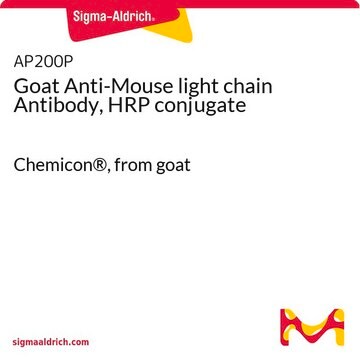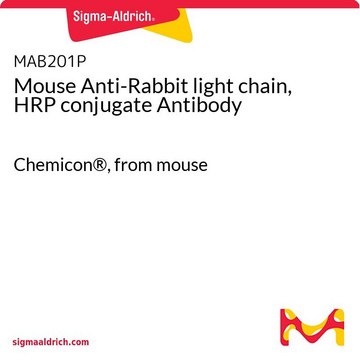MAB201
Mouse Anti-Rabbit light chain Antibody
Chemicon®, from mouse
Autenticatiper visualizzare i prezzi riservati alla tua organizzazione & contrattuali
About This Item
Codice UNSPSC:
12352203
eCl@ss:
32160702
NACRES:
NA.46
Prodotti consigliati
Origine biologica
mouse
Livello qualitativo
Coniugato
unconjugated
Forma dell’anticorpo
ascites fluid
Clone
monoclonal
Reattività contro le specie
rabbit
Produttore/marchio commerciale
Chemicon®
tecniche
ELISA: suitable
western blot: suitable
Isotipo
IgG1κ
Condizioni di spedizione
wet ice
modifica post-traduzionali bersaglio
unmodified
Descrizione generale
Antibody molecules typically comprise two immunoglobulin light chains covalently bound to a pair of heavy chains. Immunoglobulin light chains occur in two types, designated by the Greek letters kappa and lambda. Kappa and gamma light chains are approximately 250 amino acids in length with an average mass of about 25 kDa. The ratio of kappa to lambda found in the immunoglobulin population varies by species.
Specificità
Minimal cross-reaction with bovine, goat, Armenian hamster, horse, human, mouse, rat, and sheep.
The antibody reacts strongly with native primary antibodies primarily with kappa light chains. It is not suitable for detecting lambda light chains. The antibody does not react with the heavy chain of rabbit IgG. The antibody has been tested by ELISA and adsorbed to ensure minimal cross-reaction with bovine, goat, Armenian hamster, horse, human, mouse, rat, and sheep immunoglobulins.
Immunogeno
Epitope: Kappa light chain
Prepared from rabbit IgG light chain.
Applicazioni
Research Category
Secondary & Control Antibodies
Secondary & Control Antibodies
Research Sub Category
Fragment Specific Secondary Antibodies
Fragment Specific Secondary Antibodies
This Mouse anti-Rabbit light chain Antibody is validated for use in ELISA, WB for the detection of Rabbit light chain.
Descrizione del bersaglio
25 kDa
Stato fisico
Ascites
Isolated from ascites by chromatographic procedures. Liquid in 0.01M Sodium Phosphate, 0.25M NaCl, pH 7.6.
Stoccaggio e stabilità
Maintain refrigerated at 2°-8°C under sterile conditions for up to twelve months from date of receipt. Avoid repeated freeze/thaw cycles.
Note legali
CHEMICON is a registered trademark of Merck KGaA, Darmstadt, Germany
Esclusione di responsabilità
Unless otherwise stated in our catalog or other company documentation accompanying the product(s), our products are intended for research use only and are not to be used for any other purpose, which includes but is not limited to, unauthorized commercial uses, in vitro diagnostic uses, ex vivo or in vivo therapeutic uses or any type of consumption or application to humans or animals.
Codice della classe di stoccaggio
12 - Non Combustible Liquids
Classe di pericolosità dell'acqua (WGK)
WGK 2
Punto d’infiammabilità (°F)
Not applicable
Punto d’infiammabilità (°C)
Not applicable
Certificati d'analisi (COA)
Cerca il Certificati d'analisi (COA) digitando il numero di lotto/batch corrispondente. I numeri di lotto o di batch sono stampati sull'etichetta dei prodotti dopo la parola ‘Lotto’ o ‘Batch’.
Possiedi già questo prodotto?
I documenti relativi ai prodotti acquistati recentemente sono disponibili nell’Archivio dei documenti.
Charles E Evans et al.
Neurobiology of aging, 75, 136-149 (2018-12-21)
β-Amyloid (Aβ) accumulation is an early event of Alzheimer's disease (AD) pathogenesis. Inhibition of Aβ production by β-secretase (BACE) has been proposed as a potential therapeutic strategy for AD. However, BACE inhibitors lack specificity and have had limited clinical benefit.
Javier Garzón-Niño et al.
International journal of molecular sciences, 24(1) (2023-01-09)
The opioid peptide β-endorphin coexists in the pituitary and brain in its αN-acetylated form, which does not bind to opioid receptors. We now report that these neuropeptides exhibited opposite effects in in vivo paradigms, in which ligands of the sigma
Michael J Tuvim et al.
The Journal of biological chemistry, 284(15), 9781-9787 (2009-02-12)
Synaptotagmin 2 (Syt2) functions as a low affinity, fast exocytic Ca(2+) sensor in neurons, where it is activated by Ca(2+) influx through voltage-gated channels. Targeted insertion of lacZ into the mouse syt2 locus reveals expression in mucin-secreting goblet cells of
Jung-Lin Wu et al.
Nature communications, 7, 12526-12526 (2016-08-25)
Crosslinking of B-cell receptor (BCR) sets off an apoptosis programme, but the underlying pathways remain obscure. Here we decipher the molecular mechanisms bridging B-cell activation and apoptosis mediated by post-translational modification (PTM). We find that O-GlcNAcase inhibition enhances B-cell activation
Il team dei nostri ricercatori vanta grande esperienza in tutte le aree della ricerca quali Life Science, scienza dei materiali, sintesi chimica, cromatografia, discipline analitiche, ecc..
Contatta l'Assistenza Tecnica.








